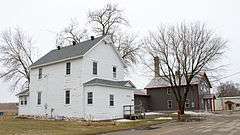Swany White Flour Mills
|
Freeport Roller Mill and Miller's House | |
|
What remains of the Freeport Roller Mill and Miller's House: The house (built 1900) remains standing, but the original mill (also known as the Swany White Mill) burned down on December 27, 2011 and all that remains is the stone chimney in the background; the gray building in between is not a part of the NRHP listing. | |
  | |
| Location | Freeport, Minnesota |
|---|---|
| Coordinates | 45°39′43″N 94°41′17″W / 45.66194°N 94.68806°WCoordinates: 45°39′43″N 94°41′17″W / 45.66194°N 94.68806°W |
| Area | Less than one acre |
| Built | 1898 |
| Architect | Unknown |
| Architectural style | No Style Listed |
| MPS | Stearns County MRA |
| NRHP Reference # | [1] |
| Added to NRHP | April 15, 1982 |
Swany White Flour Mills was a small flour mill in Freeport, Minnesota, United States. The miller was Gary Thelen, and the mill had been owned by the Thelen family since 1903.[2] The mill is listed on the National Register of Historic Places as Freeport Roller Mill and Miller's House.[1][3] On Tuesday, December 27, 2011, a fire destroyed the 114-year-old mill. The mill was a total loss. The miller's house, built in 1900, remains standing.
History
The mill had operated continuously at the same location since 1903, although according to Stearns County, the mill dates to 1898.[4] Swany White Flour Mills had been owned by the Thelen family from its inception. When it was first built, it was powered by steam, and in 1966 it was converted to electricity.
When it was built, the mill was one of a number of small mills throughout Minnesota where local farmers could sell their wheat close to home rather than having to ship it to large mills located in Minneapolis. At the mill, they could outright sell their grain or trade raw wheat for ground flour for their own family's use. The builder of the Swany Mill, Anton Hoeschen, did not intend to run the mill himself. Instead, he saw it as an investment in the community and hoped that he would find a buyer who wanted to be a miller. After several ownership changes in its first few years, the mill was bought in 1903 by Hubert and Peter Thelen, who ran the mill together. They chose the name Swany White for their brand of white flour to suggest that their product was as white as a swan.[5]
In 1913, the brothers remodeled the mill, adding a basement and more manufacturing space. The changes made the mill more efficient, and it was able to produce twice as much flour as it had before. After Peter Thelen's retirement in 1953, his son Walter took over the mill. In 1966, he replaced the steam-driven engine, that the mill had had since it was built, with an electric motor.[5]
While other small mills were not able to remain profitable during an era of increased consolidation and a downturn in Minnesota wheat production, Walter Thelen came up with a way to keep the mill profitable by producing a slightly different product. During the 1970s, he persuaded organic growers to produce organic flour, and he made arrangements with specialty bakers in area. His strategy worked, and Swany White Flour was sold in cooperatives and natural foods stores in Minnesota. He also sold flour as far away as the East Coast.[5]
In 1980, the mill was placed on the national register of historic places, but it remained a working mill. In 1998, Walter's son Gary took over the family business when he bought it from his father. By that time, the Swany White Flour Mill had become a Minnesota landmark. When photographer Richard Olsenius spent time in Freeport looking for places that had inspired Garrison Keillor's Lake Wobegon, he photographed Gary Thelen and his mill. Members of local bread clubs would also visit to see how a century-old mill worked.[5]
Swany White Mill burned down on December 27, 2011. It took over five surrounding fire agencies to put out the blaze. The fire was reported at 4:48 P.M. by an employee. That night, people gathered all around to watch the historic building burn while holding hands and crying.[6]
Production
For white flour, Swany White had used the same milling equipment since 1913. It had a milling capacity of about 1,000 pounds (450 kg) per hour, or 12,000 lb (5,400 kg) per business day.[7] This was a fraction of the milling capacity of most mills. It is notable that Swany White Flour had continued to operate as a small independent while most other small regional producers have either given up or sold out.
For its conventional products, the mill had a commercial presence mainly in the Upper Midwest, however its organic products were distributed more widely.[7] In addition to sales to distributors and retailers, Swany White had a retail outlet at the mill in Freeport. The mill's most popular product was a bleached flour sold under the brand name Faith's Best, which accounted for about 60% of all sales.[7]

References
 This article incorporates text from MNopedia, which is licensed under the Creative Commons Attribution-ShareAlike 3.0 Unported License
This article incorporates text from MNopedia, which is licensed under the Creative Commons Attribution-ShareAlike 3.0 Unported License
- 1 2 National Park Service (2007-01-23). "National Register Information System". National Register of Historic Places. National Park Service.
- ↑ Keillor, Garrison (December 2000). "In Search of Lake Wobegon". National Geographic. 198 (6–): 98.
- ↑ "Stearns County Multiple Resource Area" (PDF). National Park Service. Retrieved 2008-04-03.
- ↑ Stearns Pg.12-13 resend.eps
- 1 2 3 4 Eric Weber (19 October 2012). "The Swany White Flour Mill". MNopedia. Minnesota Historical Society. Retrieved November 3, 2012.
- ↑ Bowen, Amy; Dave Aeikens (2011-12-27). "Fire destroys iconic Freeport flour mill". St. Cloud Times. St. Cloud, Minn. Retrieved 2013-03-28.
- 1 2 3 Honest Weight Food Coop
